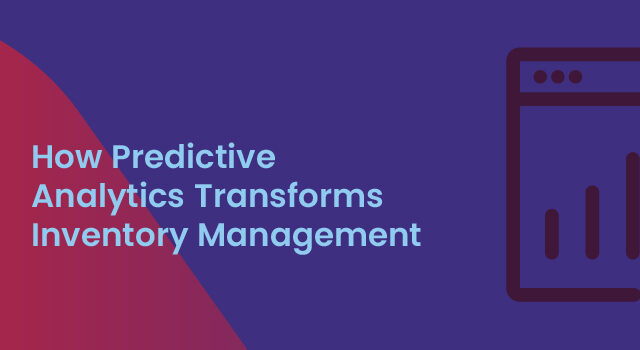Every business strives for operational efficiency and customer satisfaction. Effective inventory planning is at the core, as it ensures balanced stock management. The aim is to have enough inventory without investing in unproductive excess stock. When inventories are optimized, the business can avoid stock-outs and lost sales. Reducing inventory levels can also release capital.
A reliable supply chain is a prerequisite for optimized inventories and can be a powerful competitive advantage. Through effective inventory planning, you can grow your business and cut costs.
The ins and outs of inventory planning
Inventory planning is the systematic process of forecasting demand, setting stock levels, and creating purchasing, storage, and inventory management procedures. Effective inventory management forms the foundation for a successful supply chain.
Inventory management finds the sweet spot between supply and demand, carrying neither too little nor too much stock. If you have too little stock, you’ll lose sales and customers to your competitors. Too much stock raises storage, insurance, and spoilage costs. Excess stock increases the risk of obsolescence and keeps capital tied up in unproductive assets.
An effective inventory management system controls all processes in the inventory lifecycle. Lifecycle stages include:
- Purchasing: Finding a reliable supplier to supply quality products at the best price.
- Storing: Keeping the stores in an ideal condition to preserve product quality.
- Using: Meeting production or sales demands.
- Tracking: Monitoring inventory levels in real-time to ensure data accuracy.
- Reordering: Knowing when and how much inventory to order based on demand forecasts.
- Forecasting: Accurately predicting future demand.
Benefits of effective inventory planning
Effective inventory planning yields many benefits.
Operational Efficiency
With effective inventory planning, the right amount of inventory should arrive at the right time. Stockouts will be rare despite reduced inventory levels. Stock arrives as you need it for production or sales. You’ll create a continuous flow of goods through the operation with no production or sales delays.
Cost Reductions
Inventory optimization ensures that there are no excess inventories. Inventory holding costs drop as a result. Inventory holding costs include storage, insurance, spoilage, and obsolescence costs. Expedited orders have become a thing of the past along with expensive last-minute transport costs.
Customer Satisfaction
Customers will know that they can depend on your business to supply the items they need when they need them. This is the basis for customer satisfaction and loyalty.
Challenges in inventory planning
Despite its many benefits, inventory planners face many challenges.
Demand fluctuations
Demand forecasts are notoriously inaccurate. Demand fluctuations are a reality. Seasonality, market trends, and unforeseen circumstances affect demand. Inventory planners must foresee these demand changes to maintain optimal inventory levels.
Lead time variability
Lead time represents the time the supplier takes to deliver your purchase order to your store from when the order is placed. Inconsistent lead times can cause major supply disruptions, resulting in stockouts. Shorter lead times can mean more frequent ordering. Planners must balance order costs with inventory holding costs to reduce expenses.
SKU proliferation
Many Stock Keeping Units (SKUs) add to inventory management complexity. Planners must prioritize urgent orders without losing sight of slower-demand items. Complex supply chains with many SKUs need the most effective inventory planning strategies.
Inventory planning methods and models
There are several inventory planning methods that inventory planners can use.
Economic Order Quantity (EOQ)
The EOQ determines the best order quantity to balance the total ordering cost with the inventory holding cost. The EOQ formula includes each item’s demand with the holding and order costs.
Reorder point model
The reorder point is the inventory level at which you should place a new order. When inventory falls below the order point it is time to place an order. The reorder point formula includes average daily demand, lead time, and the required safety stock.
Safety stock planning
Safety stock is a buffer against unexpected demand changes or late deliveries. Safety stock ensures you have stock to cover demand when supply or demand varies.
ABC analysis
ABC analysis classifies inventory items into three categories based on item value and consumption. The analysis is based on the Pareto principle that 20% of items account for 80% of the value.
The ABC analysis helps businesses to focus their efforts on more critical items. A-Items are high-value, high-demand items that need close management and control. Businesses often apply Just-in-Time strategies to these items. B and C items need less stringent and minimal controls respectively.
Minimum Order Quantity (MOQ)
The MOQ is the smallest amount a supplier will sell of a particular product on a single order. Where goods are imported, minimum order quantities are common. They are applied to protect economies of scale. MOQ can have a significant effect on stockholding. Planners and procurement officers should strive to negotiate the size of the required order downward.
If the order size affects the unit price. Include the price difference in the MOQ calculation to make the best choices.
Leveraging technology for effective inventory planning
Though some businesses still manage inventories on spreadsheets, these systems are hopelessly inadequate. Modern inventory technologies make it much easier to optimize stocks.
Inventory Management Software
Inventory Management software provides a central platform for inventory control and management. You can expect the following functionality:
- Real-time tracking: Employees can see the current inventory status across various locations. Now, you can immediately identify potential stockouts before they happen and place orders.
- Automation: Modern inventory management software automates order placement and other tasks. This removes the human element, reducing errors.
- Demand forecasting: Use historical sales, market trends, and planned promotions to create accurate forecasts and drive an efficient supply chain. Accurate forecasting reduces stockout risks and minimizes lead times.
- Data analytics: Combine real-time data with analytics tools to uncover insights. Use it to analyze trends, identify slow-moving products, and optimize inventories.
AI and machine learning
AI and machine learning are the latest developments in inventory management. AI can analyze vast amounts of data to create high-level forecasts. These systems include external factors like weather conditions and social media activity. They can forecast demand changes with much higher accuracy than previously possible.
They analyze real-time data. Then, they adjust planned inventory levels to respond to anticipated demand changes.
Best practices for effective inventory planning
Effective inventory management is built upon solid principles and best practices.
Cross-functional collaboration
As with most functions, open interdepartmental communication and collaboration build a solid base for effective inventory management. All departments must work toward an efficient supply chain.
Data-Driven decision making
All inventory management decisions must be based on accurate, real-time data. Inventory management software must produce reports that provide real-time insights. Analytics tools, charts, and what-if scenarios must present easy-to-use and interpret data.
Continuous improvement
The business environment is constantly changing. Your inventory management strategies must evolve to meet the latest challenges. Ensure that your planning keeps pace with the market and changing customer demands. Review your inventory data, analyze trends, and adapt your approach, and your business will benefit.
Release capital and grow your business
Every successful business needs an effective inventory planning process. Without it, businesses will lose sales and, ultimately, customers. Excess inventories misdirect capital that could be used for paying off business debt or expansion projects.
Modern inventory management software incorporates AI and machine learning to generate sophisticated demand forecasts. Accurate forecasts can streamline the supply chain, reducing lead times. Now you can replenish stocks in the right quantities at the right time, reducing inventory levels without risking stock-outs.




